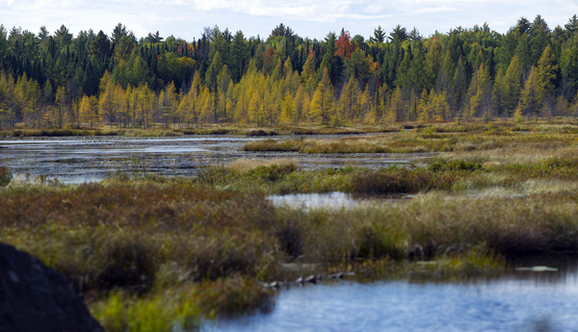 Banking on wetlands
By CASEY WARNER
Michigan Department of Natural Resources
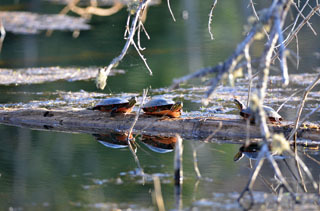 May in Michigan – a time to celebrate warmer weather,
greener scenery and the chance to jump back into outdoor pastimes like birding,
biking, fishing and camping.
This month also marks another cause for celebration, one
that’s vital to the natural resources that make enjoying Michigan’s outdoors
possible.
May is American Wetlands Month, when organizations around
the country celebrate the importance of wetlands to our water resources,
wildlife and way of living.
Areas where land and water meet, also known as swamps, bogs
or marshes, wetlands provide habitat for wildlife and recreation opportunities
for hunters, birdwatchers and others.
|
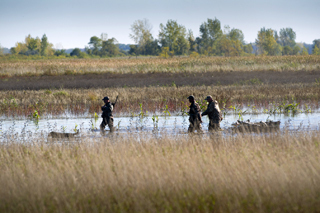 They also play a key role in the health of Michigan’s
environment, improving water quality by filtering out pollutants and excess
nutrients, replenishing surface and underground drinking water sources, and
helping to control flooding by soaking up extra rainwater.
Learn
more about wetlands and their value to Michigan’s wildlife, environment and
citizens.
Although we now recognize wetlands as a vital resource,
that wasn’t always the case.
Over the last 200 years, more than 4 million acres of
wetlands in Michigan have been drained – about half of the wetlands in the
state before European settlers arrived.
To stem the loss of wetlands, federal law now puts
restrictions and conditions on development of wetland property.
Sometimes impacts to wetlands are unavoidable in carrying
out other important work, such as farming and public infrastructure projects
like building roads.
That’s where a process called wetland mitigation comes in –
creating or restoring wetlands to replace the functions of those that will be
lost.
|
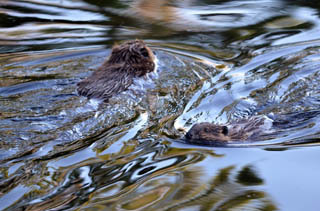 “Wetland mitigation ensures that there is no net loss of
wetlands,” said Steve Shine, wetlands mitigation bank administrator for the
Michigan Department of Natural Resources. “The goal is to replace wetland
functions that provide public benefit – fish and wildlife habitat, flood
storage, water-quality protection, groundwater recharge.”
Shine explained that mitigation is only considered for a
project after wetland impacts have been avoided or minimized.
Complying with wetland mitigation requirements – a
condition of many state and federal permits issued – can be challenging.
“Mitigation construction on a per-project basis can be very
complicated, expensive and time-consuming, and public infrastructure projects
can be delayed or put on hold due to costly mitigation requirements,” said
Stacy Hissong, an attorney specializing in drain law and public projects who
works closely with the Michigan Municipal Wetland Alliance. This organization is
partnering with the DNR to restore wetland habitat on public lands to offset
unavoidable impacts to existing wetlands.
|
 Wetland mitigation banking helps make the whole process
easier.
New wetland areas – or “banks” – are established before development
or other projects impact existing wetland areas. Each new acre in an approved
wetland mitigation bank represents a bank “credit” – sold to permit holders to
satisfy mitigation requirements associated with the permit.
“In the past, Michigan municipalities and farmers had few opportunities
to utilize wetland mitigation bank credits because their only option was to
purchase privately owned credits on the open market. Unfortunately, these
private bank credits are not available in some areas of the state, and they can
be cost-prohibitive,” Hissong said.
The Michigan Municipal Wetland Alliance offers affordable
wetland mitigation bank credit opportunities to Michigan municipalities, as
well as agricultural producers and blueberry growers.
The nonprofit organization is using grant funds from the
Michigan Department of Environmental Quality and the DNR to create
high-functioning, professionally managed and maintained wetland mitigation
banks, encouraging long-term sustainability, high water quality and
biologically diverse ecosystems.
|
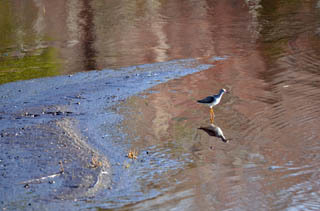 “Buying credits offsets the impact to wetlands,” Shine
said. “The restored wetland area has to be located in the same watershed as the
impacted wetland, and 1.5 times the size of the impacted area.”
The public-private partnership between the Alliance and the
DNR also helps to make compliance with strict wetland mitigation requirements
less complicated, less expensive and less time-consuming for Michigan
municipalities.
“The DNR will maintain ownership of the land and maintain
the wetland mitigation banks in perpetuity, which means that municipalities,
agricultural producers and blueberry growers can rest assured that their
wetland mitigation requirements have been properly fulfilled,” Hissong said.
“By using state-owned lands, we’re able to save the purchase price of the bank
sites. In this way, the benefit of the public-private partnership between the
DNR and the Michigan Municipal Wetland Alliance is passed on to the taxpayer in
the form of substantial savings.”
Hissong said that private bank credits cost up to $100,000
per acre credit, but with the DNR’s assistance, the Alliance is able to offer a
more affordable cost of up to $30,000 per acre credit for those who need to buy
wetland mitigation bank credits.
|
 "We are so glad to be a part of the partnership with
DNR. It provides a great environmental enhancement while giving our taxpayers up
to a $70,000 savings on wetland credits,” said David Thompson, president of the Alliance’s board of directors. “There isn't a downside to this. It just makes
sense."
Construction is set to begin soon on four new wetland
mitigation banks on DNR-managed lands at Allegan State Game Area in Allegan
County (52.4 acres), Grand River State Game Area in Ionia County (21.7 acres),
Gratiot-Saginaw State Game Area in Gratiot County at (71.6 acres) and
Petersburg State Game Area in Monroe County (50 acres).
“Each of the sites has different land features, which will
create wetlands that are also unique,” Shine said. “We are trying to achieve as
much open water as the rules allow us to establish, which is not to exceed 15
percent. The balance of the sites is a blend of wet meadow, emergent wetland
and scrub shrub wetlands. The variety of wetland types creates habitat for a
broad range of wildlife.”
Establishing wetland mitigation bank sites across the state
will expedite municipal road, bridge and other infrastructure projects and
benefit Michigan’s environment, while restoring wetlands on state-owned land
will enhance recreational opportunities for the public.
|
 “Michigan has world-class waterfowl hunting opportunities
because of the abundance, the quality and the diversity of the wetlands we have
in our state,” said Barb Avers, DNR waterfowl and wetlands specialist. “From
coastal wetlands, to marshes, to fens (low and marshy or frequently flooded
areas), swamps and bogs (wet, muddy ground), Michigan has a lot of important
wetland habitat to offer.”
This same wetland habitat that provides excellent hunting
locations also attracts a variety of birds that wildlife watchers enjoy.
“Every birder knows that wetlands have the best diversity
of bird species. In many different seasons, you can find waterfowl, wading
birds, shorebirds, gulls, hawks, eagles, wrens, blackbirds, cranes, swallows
and so much more,” said Holly Vaughn, DNR wildlife communications coordinator. “We
have some really exceptional birdwatching opportunities in Michigan because of
our outstanding wetlands and the important benefits that they provide to
wildlife – feeding, nesting and migration stopover habitat.”
The recreational opportunities wetlands provide are not
limited to hunting and birding.
“Wetlands offer opportunities for great wildlife
photography with their diversity of birds, mammals, reptiles, amphibians and
insect life,” Vaughn said. “A quiet paddle around wetlands is another great way
to pass the day. In a canoe or kayak, you might sneak up on a family of beavers
or paddle next to a turtle catching its breath on the surface. You can even
throw in a line and see if you can catch some dinner while floating
around.”
Wetlands are valuable for so many reasons, it’s easy to see
why we devote a whole month to celebrating them, and wetlands banking is a
mechanism that will help us ensure future generations will be able to enjoy them.
Learn
more about how the DNR manages wetlands on public land.
Check out previous Showcasing the DNR stories
at www.michigan.gov/dnrstories.
Subscribe to future stories at www.mi.gov/dnr.
|
/Note to editors: Media contact: John Pepin, Showcasing the DNR series editor, 906-226-1352. Accompanying photos are available below for download. Caption information follows. Credit Michigan Department of Natural Resources, unless otherwise noted.
Birders: Because they attract a wide variety of birds and other wildlife, wetland areas
are popular with wildlife watchers and photographers. Here, birdwatchers enjoy
the view at Watkins Lake State Park and County Preserve near Brooklyn,
Michigan.
Green: Many
wildlife species, like this green frog in Marquette County, flourish in wetland
areas.
Hunting: The
DNR’s involvement in wetland mitigation banking will help restore wetlands on
public lands like state game areas, which will benefit waterfowl hunters and
other outdoor recreationists.
Kits:
Beaver kits enjoy playing on an evening swim, one of the attractions visitors
to a wetland area might see.
Marsh:
Wetland areas are home to beautiful plants like these marsh marigolds, known
better to some by their “cowslip” nickname.
Painted:
Painted
turtles, one of the many wetland wildlife species, enjoy a late afternoon on a log.
Sparrow:
Numerous bird species, like this song sparrow, are found in wetland areas.
Wetland:
Wetlands, like this area near Craig Lake State Park in Baraga County, play a
key role in the health of Michigan’s environment.
Yellowlegs: Mud
flats and shallow waters in wetland areas are places birds like this yellowlegs
frequent looking for food./
|